Numerical Study on the Potential of Cavitation Damage in a Lead–Bismuth Eutectic Spallation Target
Abstract
:1. Introduction
2. Configuration of LBE Spallation Target Head
3. Heat Deposition in LBE
4. Numerical Simulation Models
4.1. Model for Calculating Dynamics of Pressure Waves
4.2. Computational Fluid Dynamics (CFD) Analysis Model
5. Results and Discussions
5.1. Cavitation Damage due to Pressure Waves
5.1.1. Time Response of Pressure
5.1.2. Threshold of Cavitation Damage Initialization
5.1.3. Cavitation Bubble Expansion for LBE Spallation Target
5.2. Cavitation Damage due to LBE Flow
5.2.1. Steady-State Flow
5.2.2. Transient Flow
6. Conclusions
- The intensity of pressure waves generated in the LBE was found to be weak due to the relatively long duration of the proton beam pulse. Therefore, the expansion ratio of the cavitation bubbles due to the pressure waves, was only 1.4, which was considerably lower than the threshold ratio that could lead to severe cavitation damage on the vessel.
- The magnitude of maximum negative pressure had a second power law relationship with the flow speed of the HLM. For the nominal inlet flow speed of 0.125 m/s, the negative pressure induced by the steady-state LBE flow was only −0.013 MPa, which was considerably smaller than the cover gas pressure of the LBE spallation target; therefore, this pressure could not drive the growth of the cavitation bubbles.
- For the transient LBE flow, negative pressure was generated in the LBE, due to a decrease in LBE flow velocity. Under normal target operation conditions, the duration of negative pressure was too short to drive the growth of adequately large cavitation bubbles. However, cavitation might have occurred under a few extreme flow variation conditions, for example, when the rate of change in inlet flow was higher than 0.2 m/s2, even as the initial inlet flow speed was 0.25 m/s.
- The maximum cavitation bubble dynamics due to turbulent flow in an orifice could be classified into two stages. In the first stage, the maximum cavitation bubble expansion ratio shared a power law relationship with the inlet flow speed, but it was almost independent of the inlet flow speed change rate; in the second stage, the maximum cavitation bubble expansion ratio shared, a power law relationship with, both, the inlet flow speed and the rate of change in the inlet flow speed.
Author Contributions
Funding
Acknowledgments
Conflicts of Interest
References
- Oigawa, H.; Tsujimoto, K.; Nishihara, K.; Sugawara, T.; Kurata, Y.; Takei, H.; Saito, S.; Sasa, T.; Obayashi, H. Role of ADS in the back-end of the fuel cycle strategies and associated design activities: The case of Japan. J. Nucl. Mater. 2011, 415, 229–236. [Google Scholar] [CrossRef]
- Tsujimoto, K.; Oigawa, H.; Ouchi, N.; Kikuchi, K.; Kurata, Y.; Mizumoto, M.; Sasa, T.; Saito, S.; Nishihara, K.; Umeno, M.; et al. Research and development program on accelerator driven subcritical system in JAEA. J. Nucl. Sci. Technol. 2007, 44, 483–490. [Google Scholar] [CrossRef]
- Naoe, T.; Teshigawara, M.; Wakui, T.; Kinoshita, H.; Kogawa, H.; Haga, K.; Futakawa, M. Damage inspection of the first mercury target vessel of JSNS. J. Nucl. Mater. 2014, 450, 123–129. [Google Scholar] [CrossRef]
- McClintock, D.A.; Riemer, B.W.; Ferguson, P.D.; Carroll, A.J.; Dayton, M.J. Initial observations of cavitation-induced erosion of liquid metal spallation target vessels at the Spallation Neutron Source. J. Nucl. Mater. 2012, 431, 147–159. [Google Scholar] [CrossRef]
- Sasa, T.; Oigawa, H. Studies on Accelerator-Driven System in JAEA. Plasma Fusion Res. 2014, 9, 4401113. [Google Scholar] [CrossRef]
- Kikuchi, K.; Sasa, T.; Ishikura, S.; Mukugi, K.; Kai, T.; Ouchi, N.; Ikoda, I. Current status of JAERI spallation target material program. J. Nucl. Mater. 2011, 296, 34–42. [Google Scholar] [CrossRef]
- Sasa, T. Design of J-PARC transmutation experimental facility. Prog. Nucl. Energ. 2015, 82, 364–368. [Google Scholar] [CrossRef]
- Sato, T.; Niita, K.; Matsuda, N.; Hashimoto, S.; Iwamoto, Y.; Noda, S.; Ogawa, T.; Iwase, H.; Nakashima, H.; Fukahori, T.; et al. Particle and Heavy Ion Transport Code System PHITS, Version 2.52. J. Nucl. Sci. Technol. 2013, 50, 913–923. [Google Scholar] [CrossRef]
- Obayashi, H.; Takei, H.; Wan, T.; Kogawa, H.; Iwamoto, H.; Sasa, T. TEF Beam Window Design and Evaluation of Structural Integrity. Jps Conf. Proc. 2015, 041002. [Google Scholar] [CrossRef]
- Takei, H.; Obayashi, H.; Iwamoto, H.; Kogawa, H.; Sasa, T. Study on the Structural Integrity of Beam Window for TEF Target. In Proceedings of the Eleventh International Topical Meeting on Nuclear Applications of Accelerators (AccApp2013), Bruges, Belgium, 5–8 August 2013. WEPAD02. [Google Scholar]
- LS-DYNA keywork User’s Manual Version R: 5869; Livermore Software Technology Corporation: Livermore, CA, USA, 2014.
- Kogawa, H.; Ishikura, S.; Sato, H.; Harada, M.; Takatama, S.; Futakawa, M.; Haga, K.; Hino, R.; Meigo, S.; Maekawa, F.; et al. Effect of proton beam profile on stress in JSNS target vessel. J. Nucl. Mater. 2005, 343, 178–183. [Google Scholar] [CrossRef]
- Futakawa, M.; Naoe, T.; Kogawa, H.; Wakui, T.; Haga, K. Mercury cavitation and its mitigation technique for high power pulsed spallation neutron sources. In Proceedings of the WIMRC 3rd International Cavitation Forum, University of Warwick, UK, 4–6 July 2011. [Google Scholar]
- Futakawa, M.; Naoe, T.; Kogawa, H.; Haga, K.; Okita, K. Cavitation erosion induced by proton beam bombarding mercury target for high-power spallation neutron sources. Exp. Therm. Fluid Sci. 2014, 57, 365–370. [Google Scholar] [CrossRef]
- Keller, J.B.; Kolodner, I.I. Damping of underwater explosion bubble oscillations. J. Appl. Phys. 1956, 27, 1152–1161. [Google Scholar] [CrossRef]
- Prosperetti, A.; Lezzi, A. Bubble dynamics in a compressible liquid. Part 1. First-order theory. J. Fluid Mech. 1986, 168, 457–478. [Google Scholar] [CrossRef]
- Futakwa, M.; Naoe, T.; Kogawa, H.; Ikeda, Y. Damage Diagnostic of Localized Impact Erosion by Measuring Acoustic Vibration. J. Nucl. Sci. Technol. 2004, 41, 1059–1064. [Google Scholar] [CrossRef]
- Futakwa, M.; Naoe, T.; Tsai, C.C.; Kogawa, H.; Ishikura, S.; Ikeda, Y.; Soyama, H.; Date, H. Pitting damage by pressure waves in a mercury target. J. Nucl. Mater. 2005, 343, 70–80. [Google Scholar] [CrossRef]
- Futakwa, M.; Wakui, T.; Kogawa, H.; Ikeda, Y. Pressure wave issues in high power mercury target. Nucl. Instrum. Meth. A. 2006, 562, 676–679. [Google Scholar] [CrossRef]
- Futakwa, M.; Naoe, T.; Tanaka, N. Visualization of mercury cavitation bubble collapse. In Experimental Analysis of Nano and Engineering Materials and Structures. In Proceedings of the 13th International Conference on Experimental Mechanics, Alexandroupolis, Greece, 1–6 July 2007; Gdoutos, E.E., Ed.; Springer: Berlin, German, 2007; pp. 301–302. [Google Scholar]
- Brennen, C.E. Cavitation and Bubble Dynamics; Oxford University Press: New York, NY, USA, 1995; p. 58. [Google Scholar]
- Hegedus, F. Stable bubble oscillations beyond Blake’s critical threshold. Ultrasonics 2014, 54, 1113–1121. [Google Scholar] [CrossRef] [PubMed]
- Handbook on Lead–Bismuth Eutectic Alloy and Lead Properties, Materials Compatibility, Thermal-hydraulics and Technologies, 2015th ed.; OECD NEA: Boulogne-Billancourt, France, 2015; p. 56.
- Yada, H.; Kanagawa, A.; Hattori, S. Cavitation inception and erosion in flowing system of water and liquid metal. Trans. Jpn. Soc. Mech. Eng. Ser. B 2011, 78, 811–820. (In Japanese) [Google Scholar] [CrossRef]
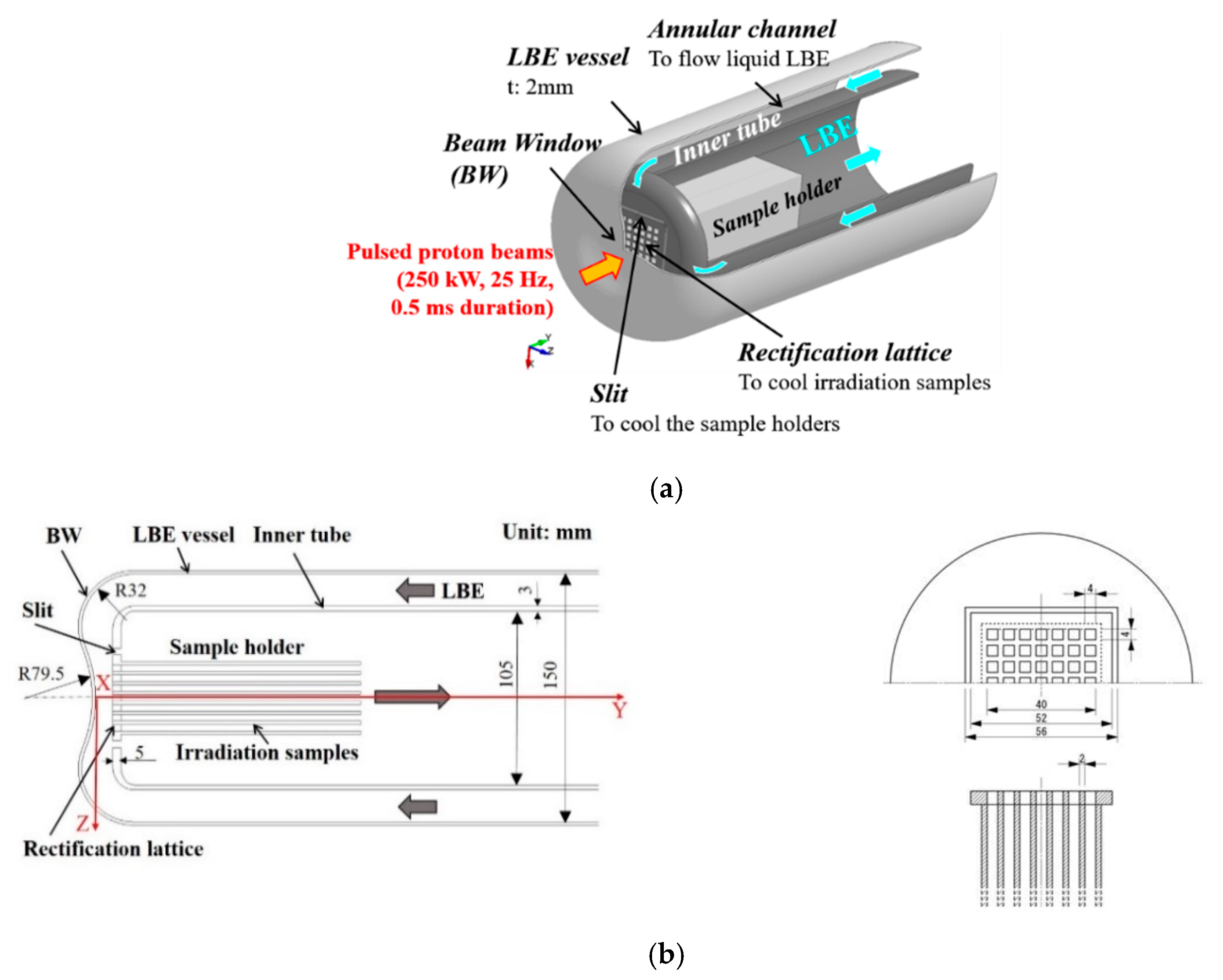

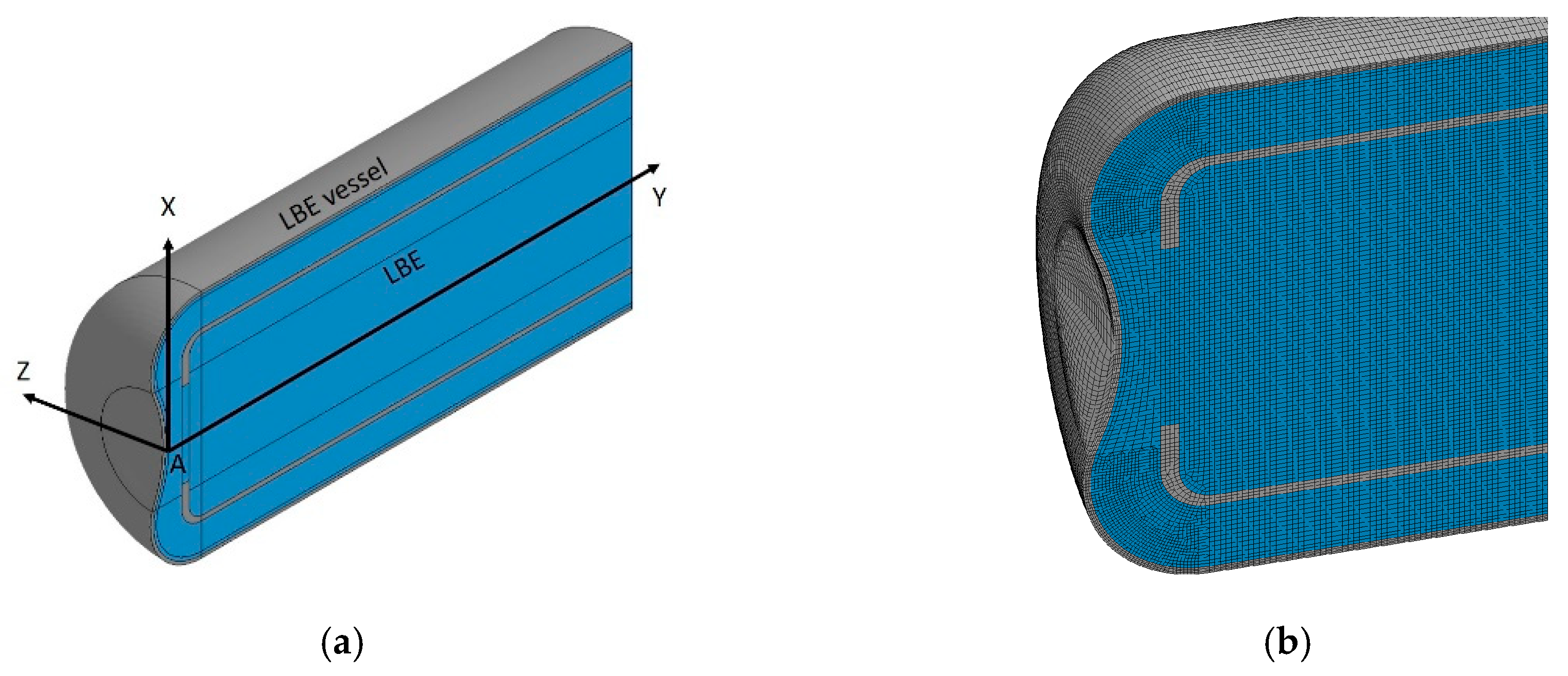

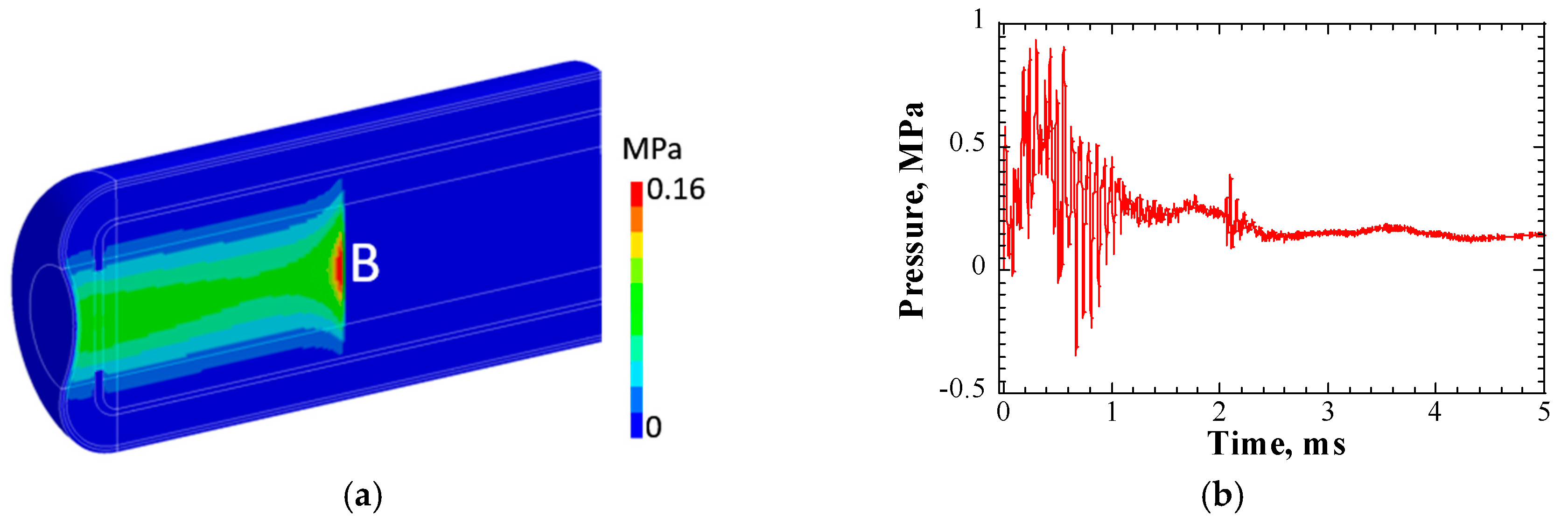
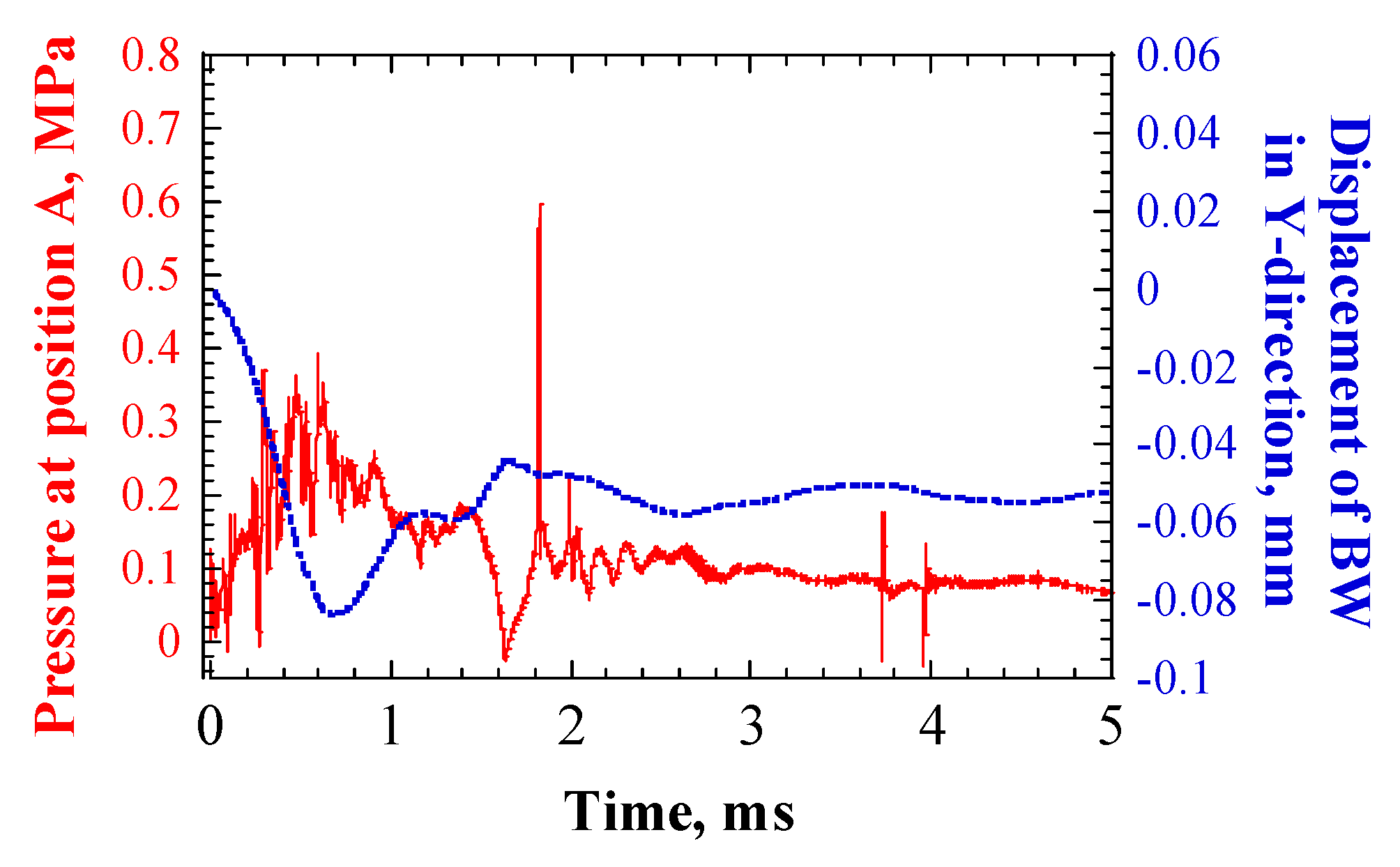
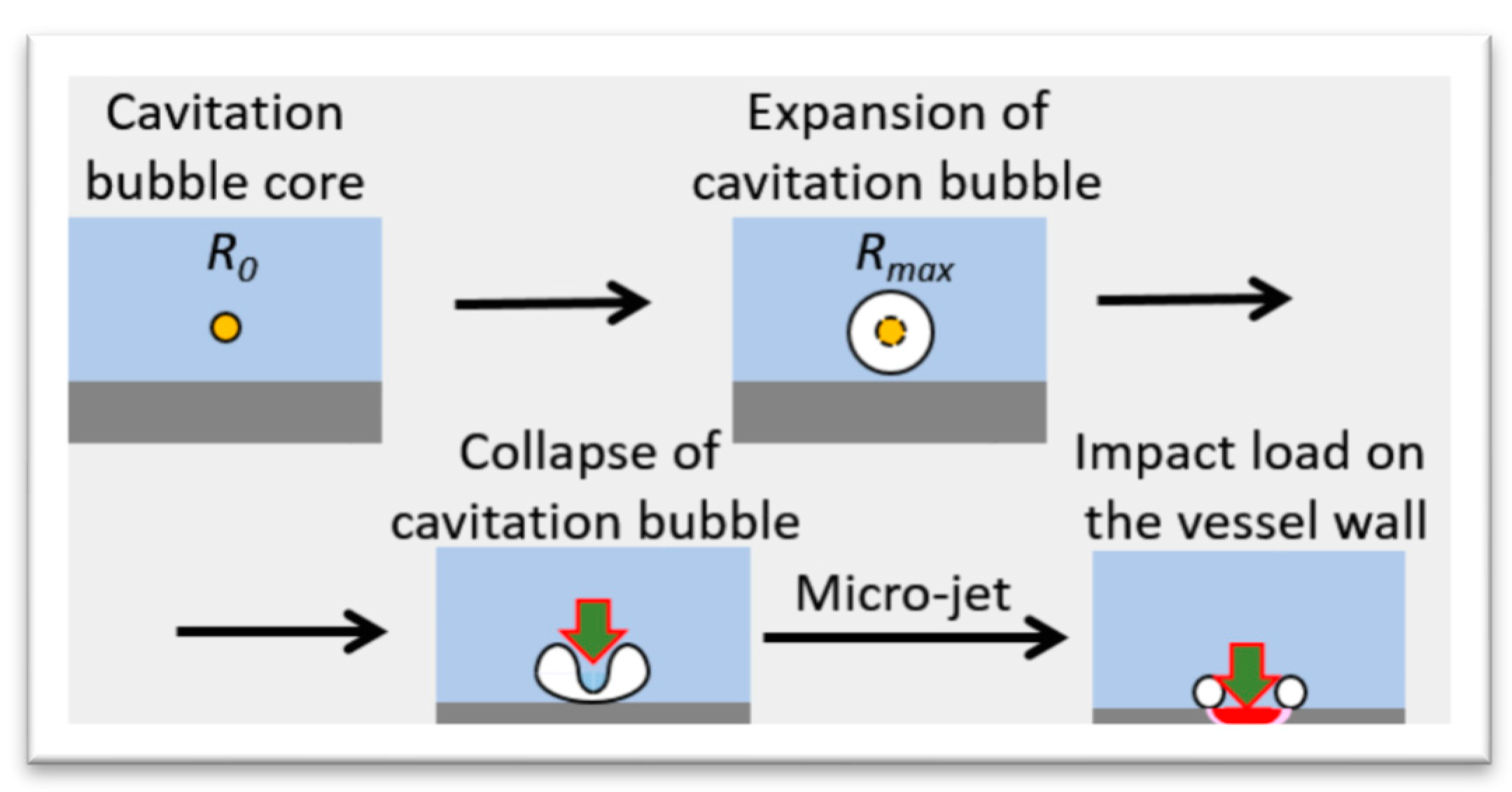
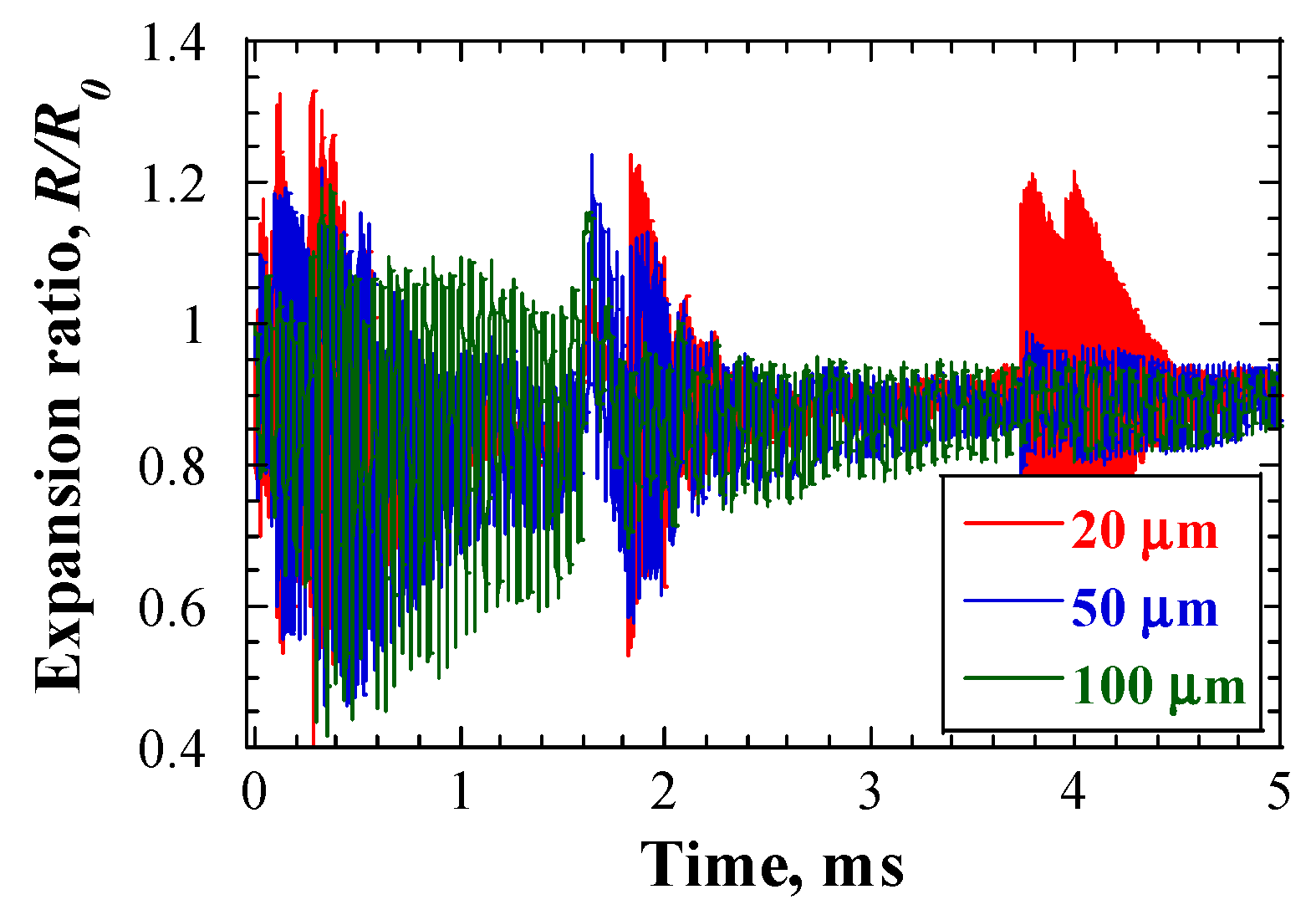
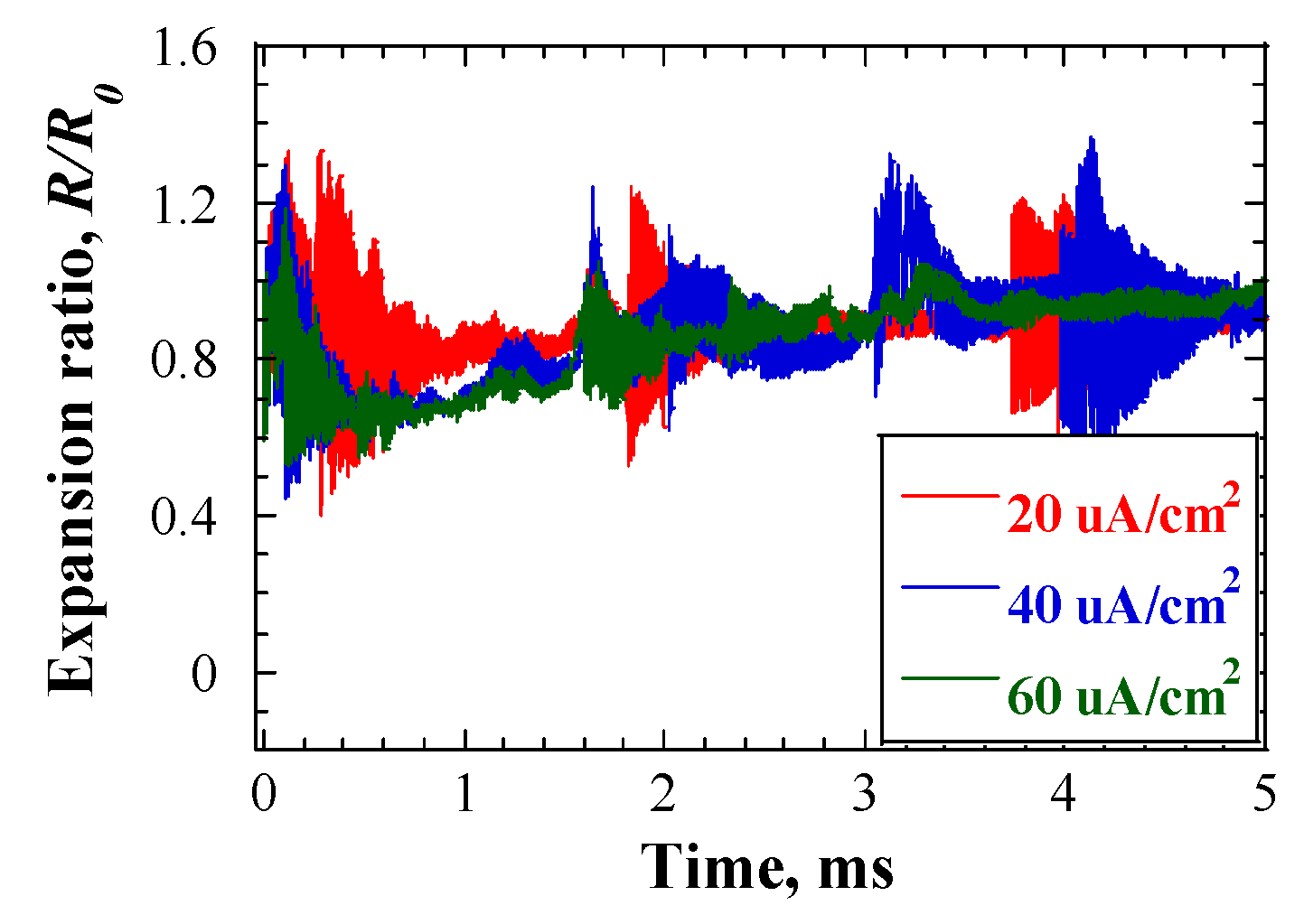
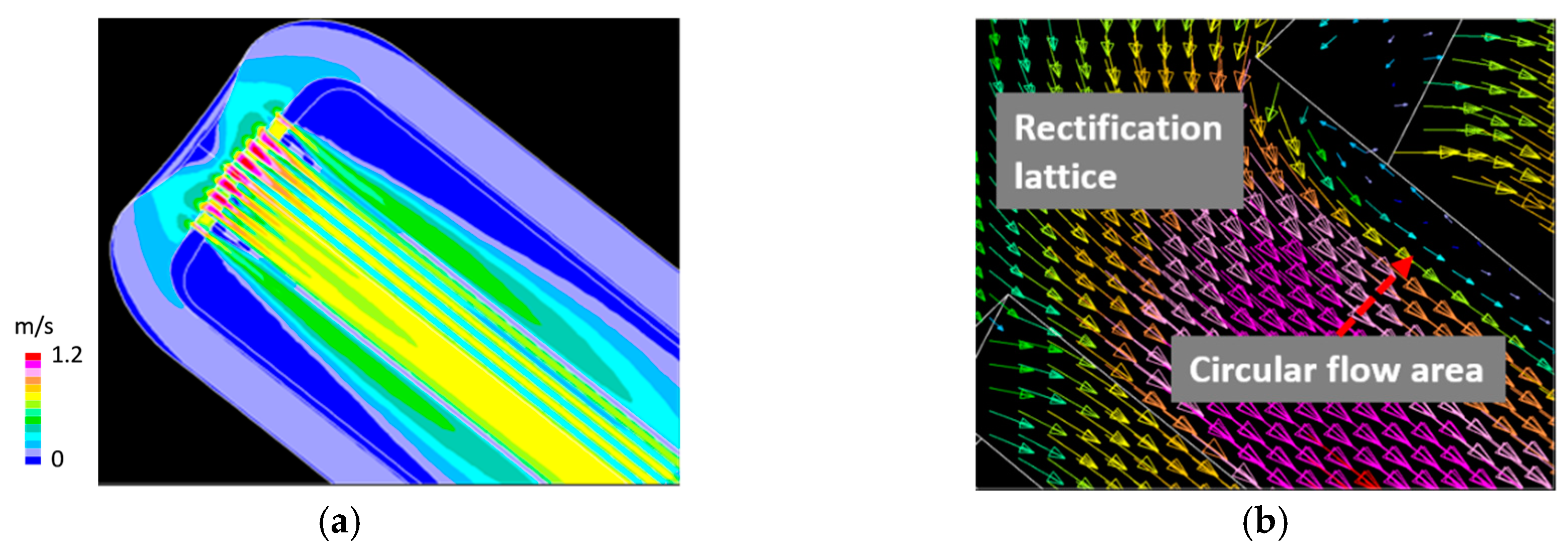
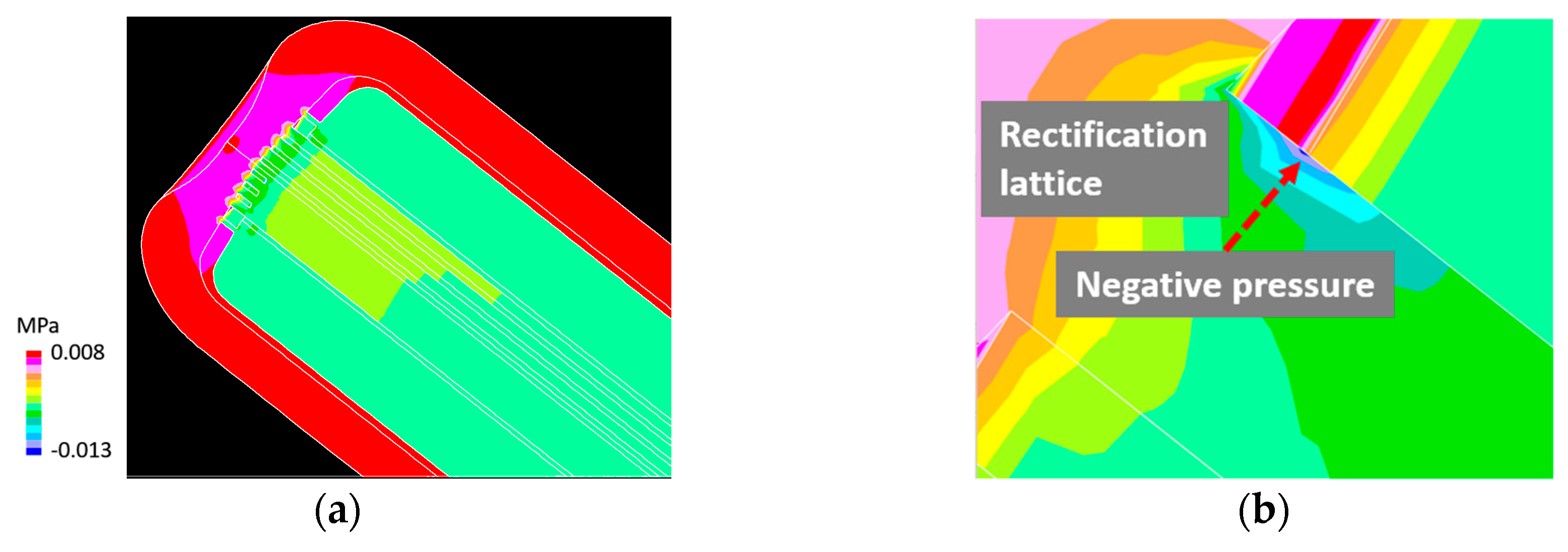
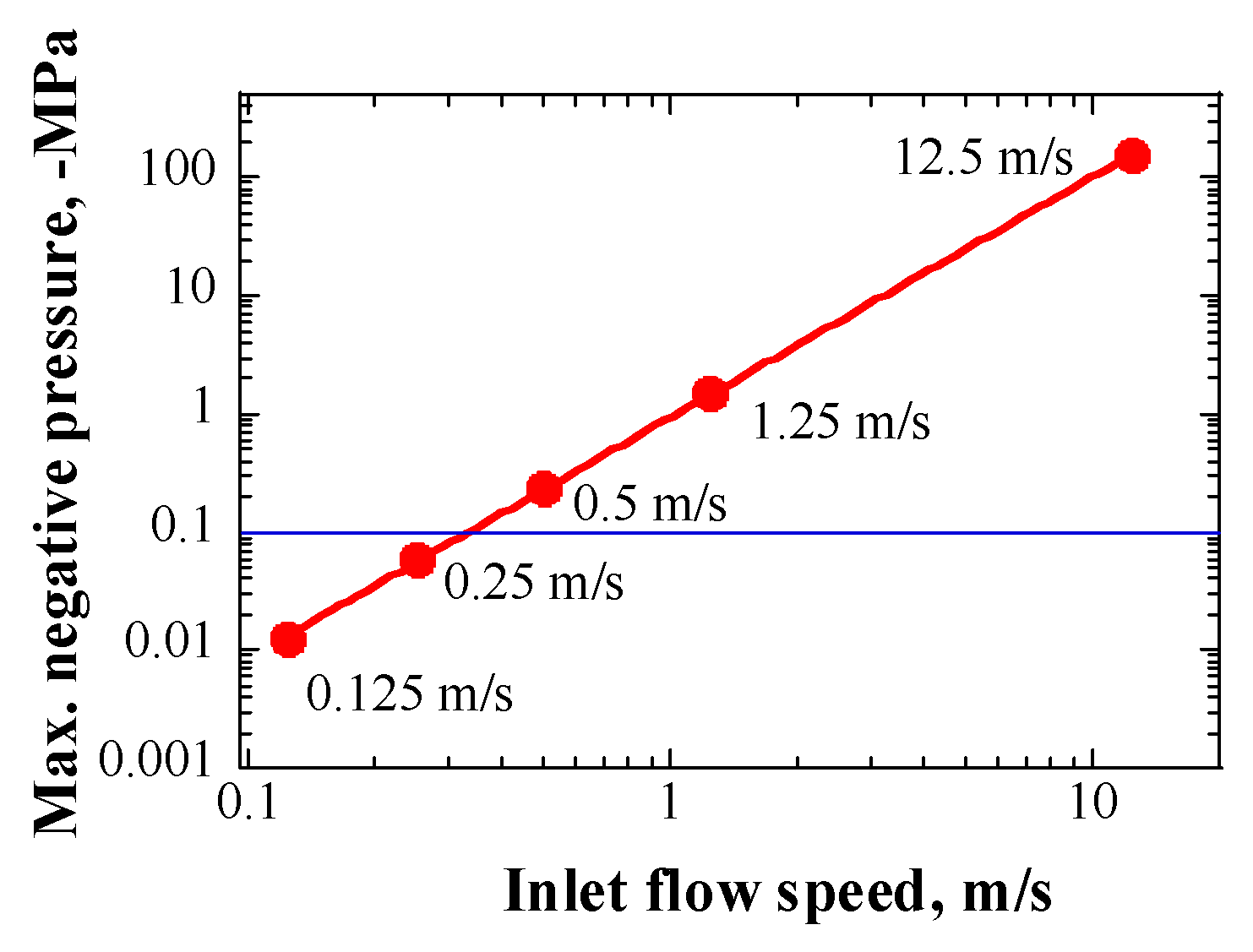
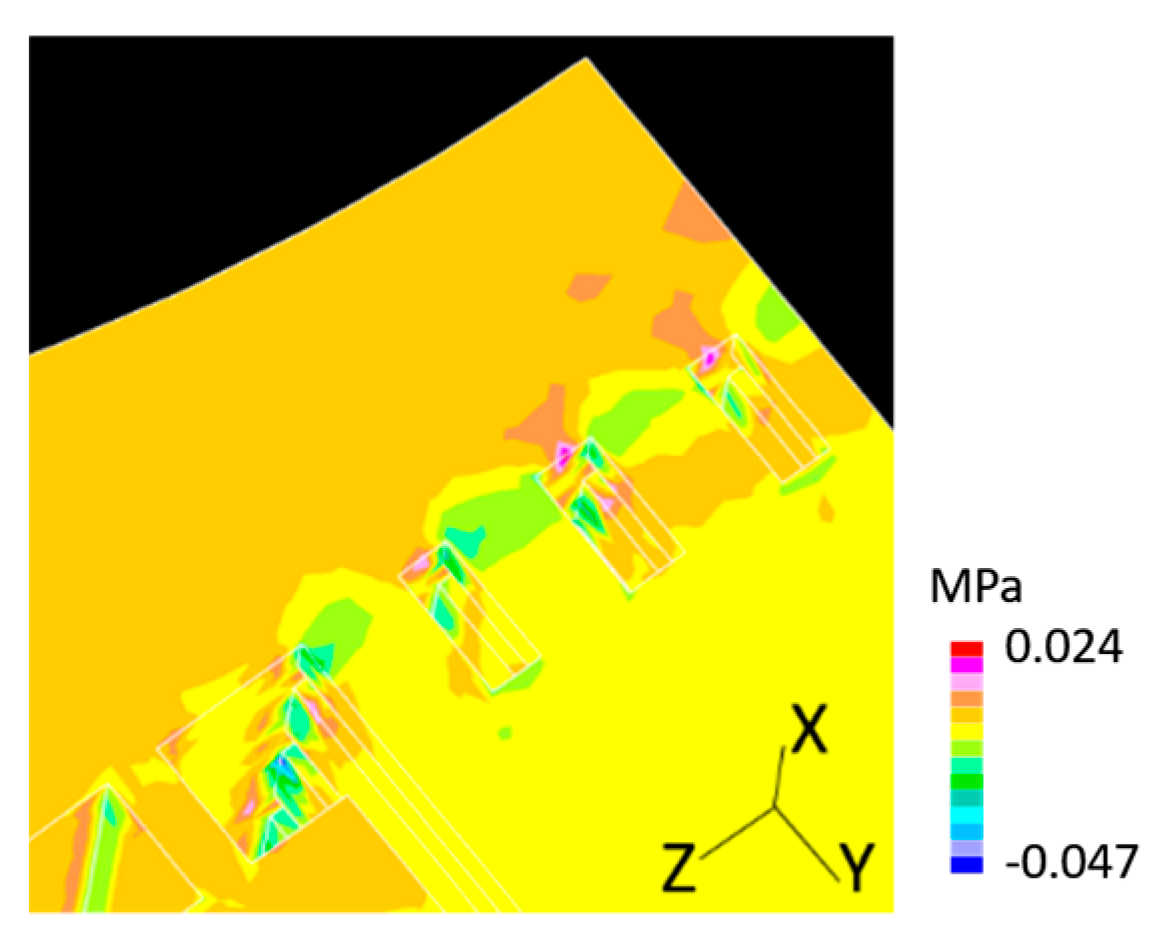


| Physical Properties | Symbol | Unit | 316 SS | LBE |
|---|---|---|---|---|
| Density | kg/m3 | 7908 | 10450 | |
| Young’s modulus | MPa | 1.742 × 105 | 92.8 | |
| Poisson’s ratio | - | 0.3153 | 0.4995 | |
| Thermal expansion coefficient | K−1 | - | 1.285 × 10−4 |
© 2019 by the authors. Licensee MDPI, Basel, Switzerland. This article is an open access article distributed under the terms and conditions of the Creative Commons Attribution (CC BY) license (http://creativecommons.org/licenses/by/4.0/).
Share and Cite
Wan, T.; Naoe, T.; Kogawa, H.; Futakawa, M.; Obayashi, H.; Sasa, T. Numerical Study on the Potential of Cavitation Damage in a Lead–Bismuth Eutectic Spallation Target. Materials 2019, 12, 681. https://doi.org/10.3390/ma12040681
Wan T, Naoe T, Kogawa H, Futakawa M, Obayashi H, Sasa T. Numerical Study on the Potential of Cavitation Damage in a Lead–Bismuth Eutectic Spallation Target. Materials. 2019; 12(4):681. https://doi.org/10.3390/ma12040681
Chicago/Turabian StyleWan, Tao, Takashi Naoe, Hiroyuki Kogawa, Masatoshi Futakawa, Hironari Obayashi, and Toshinobu Sasa. 2019. "Numerical Study on the Potential of Cavitation Damage in a Lead–Bismuth Eutectic Spallation Target" Materials 12, no. 4: 681. https://doi.org/10.3390/ma12040681
APA StyleWan, T., Naoe, T., Kogawa, H., Futakawa, M., Obayashi, H., & Sasa, T. (2019). Numerical Study on the Potential of Cavitation Damage in a Lead–Bismuth Eutectic Spallation Target. Materials, 12(4), 681. https://doi.org/10.3390/ma12040681





